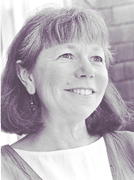'Moll' Pall
Therapist sees 'Flanders' flounder
By David Templeton
WE ARE EXACTLY 27 minutes into a screening of Moll Flanders. It is my first time seeing this adaptation of Defoe's 1722 novel, while it is Sara Halprin's second. She didn't like it the first time. Even so, she has approached Moll today with her mind firmly set on finding some redeeming quality in the film. Ha!
We are witnessing the opening movements of a scene wherein the virtue of Ms. Flanders (Robin Wright) is about to be auctioned off, against her will, to a seedy band of brothel patrons. At this point, Halprin's resolve has thoroughly evaporated.
"I'm ready to go when you are," she whispers. "Unless there's something else you need to see." I glance back at the screen. Nothing occurs to me. And with that, we're out of the theater faster than you could say "Adaptational Travesty."
Halprin, of Portland, Ore., is a former professor of English literature and an award-winning documentary filmmaker. She is a therapist in private practice, and is the author of a fascinating new work of social criticism, Look at My Ugly Face!--Myths and Musings on Beauty and Other Perilous Obsessions with Women's Appearance (Penguin Books, 1996). Arriving amid a flurry of similarly themed books, Face takes its title from the Taoist tale of Sun Pu-erh.
An intelligent 11th-century Chinese woman, Sun Pu-erh asked to study the Tao, but was denied because of her beauty, a certain distraction to the male students. After horribly scarring her features with burning oil, she returned, exclaiming, "Look at my ugly face!" No longer a sexual distraction, she was allowed to attend.
Halprin's book intelligently examines the limitations and psychological damage caused by our most cherished perceptions of beauty and ugliness. Engaging and honest, full of stories from various cultures, Face is an eye-opener.
So is Moll Flanders, the book. The film is another story.
"If they'd filmed the book, it could have been wonderful," a soft-spoken Halprin asserts over lunch. "There was no fidelity to the book whatsoever.
"If you look at the whole movie, it's just a series of stereotypes of women. This is not a woman's view of women. What's interesting about the novel is that it's not clichéd at all!," she exclaims. "It is a relentless examination of a woman whose morality is based on materialism. She has passion and lust--in the sense of results--but she reckons everything in dollars and cents.
"In the movie, she has one true love and one child," Halprin goes on, "but in the book, of course, she has five husbands, and numerous children whom she cares nothing about and she gives them all away to other people.
"I would love to see a movie really based on Moll Flanders. I think it would be incredible," Halprin laughs. "It would be very shocking."
And what about Robin Wright as Moll, a woman whose beauty (as the character states at the opening of the film), like Sun Pu-erh's, created as many problems as opportunities?
"Robin Wright was an interesting choice. She's not your standard pretty woman," Halprin answers, "though she is typically scrawny, in keeping with modern standards. If you've read Defoe, though, it's clear that Moll is not skinny. She's a fine figure of a woman, by 18th-century standards.
"The obsession with skinniness has been growing since Twiggy, I think, in the '60s," she continues. "Audrey Hepburn certainly picked up on that. But if you look at Marilyn Monroe and then you look at Robin Wright, what a difference! Marilyn was curvaceous and juicy and round, not the least bit skinny."
In the movie, Halprin contends, the skinny goodhearted heroine and the girthy, malevolent madam are just two of the many simplistic images used to place moral value on the characters. The selfish sisters are bucktoothed and awkward. The kind and maternal foster mother is plump and wrinkled. Then there's the spectral figure looming in the background as the film begins.
"The mysterious woman," as Halprin identifies her, "on whom the whole plot of the movie turns, she's out of focus, unclear. That's a big stereotype. She's the blank slate on which men can project their fantasies. The minute you see this fuzzy blur of a woman, you know you are in a mainstream movie directed from a male perspective."
Would a woman not have conceived of an image like this? A Mystery Woman?
"She might, but you would still understand that the movie was directed toward the male spectator. When Moll is portrayed as pure and chaste and holy, I know that the polar opposite of that is the image of woman as a whore, a bad, wicked woman. These are two split-off projections that have nothing to do with the complexity of male-female natures. They have entirely to do with the construction of woman by men.
"It's so odd," she laughs. "The filmmakers were as obsessed with making Moll seem pure and untouched as they were in showing her being humped by one man after another. It's quite ridiculous, isn't it?"
This page was designed and created by the Boulevards team.

Look at her pretty face: Sarah Halprin wonders at this defaced Defoe.
Writer David Templeton takes interesting people to interesting movies in his ongoing quest for the ultimate post-film conversation. This time around, he takes iconoclastic author and therapist Sarah Halprin (Look at My Ugly Face) to see the new cinematic adaptation of Daniel Defoe's Moll Flanders.
From the June 27-July 3, 1996 issue of the Sonoma Independent
Copyright © 1996 Metro Publishing and Virtual Valley, Inc.
